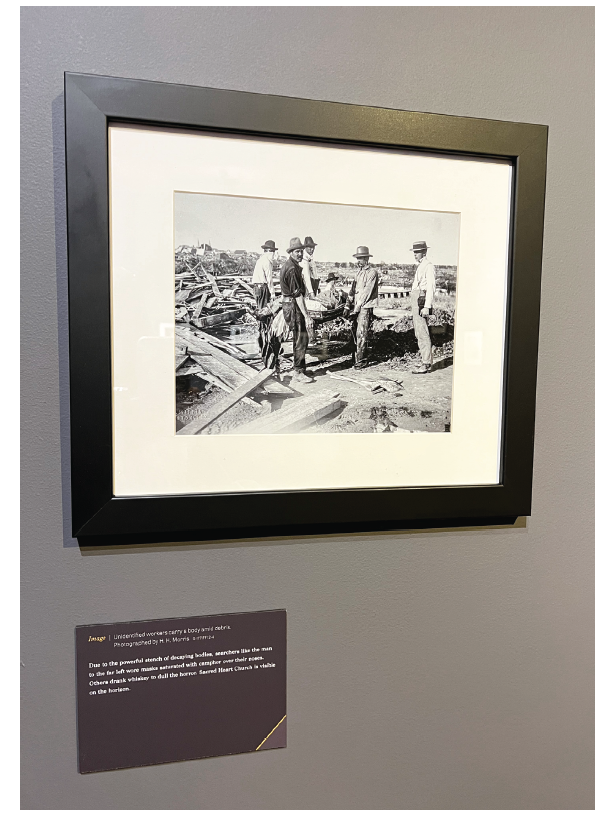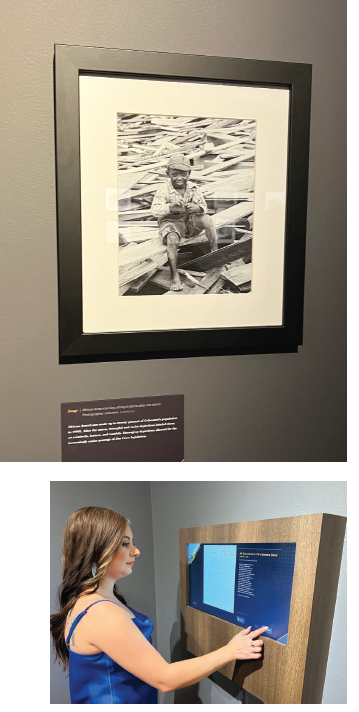Rosenberg Library Museum, which is located on the fourth floor of the Rosenberg Library, has been closed for renovations for months. The Harris Gallery portion of the museum will reopen to the public on September 8—the 122nd anniversary of the deadliest hurricane in national history—with an exhibit created by the museum’s new curator, Ivy Albright.
The exhibit, entitled “The Great Storm of 1900,” is designed to evoke a sense of empathy and vulnerability, as well as offer thought provoking ideologies around class and race.
Albright began her position at the museum a year ago, coming from her previous job at the Smithsonian Institution’s National Air & Space Museum in Washington, D.C., where she worked as a museum technician in the processing unit.
“My job was to rehouse, transport and care for objects in the collection,” Albright said. “Rehousing can be defined as taking a historical artifact and building a customized, archival box that makes sure it will stay preserved for a long time.”
She dealt with a variety of items ranging from World War II airplane wings to 1960s space food from the Apollo missions. “I even worked with Texas cowboy boots. My specialty is collections care and preserving artifacts.”
 A native of Taylor, Texas, Albright graduated with a bachelor’s degree in history from Sam Houston State University, and a master’s degree in museum studies from George Washington University in Washington, D. C.
A native of Taylor, Texas, Albright graduated with a bachelor’s degree in history from Sam Houston State University, and a master’s degree in museum studies from George Washington University in Washington, D. C.
“That program (at George Washington) is directly partnered with the Smithsonian,” she said. “It was amazing to get that immersive education and experience. I had an internship with the Smithsonian American History Museum before working at the Air & Space Museum.”
Albright said she’s delighted bring her “knowledge and expertise from being trained at the nation’s most respected museum to the Rosenberg Museum.”
Though unfamiliar with much of Galveston’s history before her arrival on the island, Albright said she’s enjoyed getting to know the area and its history.
“It’s been a lot of fun because there’s always something new to learn. The people in the community have been amazing, as well,” she said. “Everyone has so much knowledge to share, and I find that incredibly touching.”
Being a native Texan, Albright said she’d, of course, heard about the catastrophic and historic hurricane, but she didn’t know much about it. Her interest was piqued by storm survivor storm plaques on Galveston homes, the storm memorial on the seawall, and other references to the event.
“There was a video that used to play put on by Galveston Historical Foundation (“The Great Storm”), that unfortunately doesn’t play on the island anymore,” she said.
“I received a lot of calls about it because there was a rumor going around that we (Rosenberg Library Museum) had the film. People are interested, but there was no central place to go for information and context. It became kind of a passion project for me.”
The “passion project” led to her very hands-on approach in curating the new exhibit.
“I hand-picked every photo in the gallery, going through over 1,000 photos and doing the research myself. I also wrote the content for the display and worked with a graphic designer to come up with the layout and look.”
Thanks to the extensive collection of Rosenberg’s Galveston & Texas History Center (GTHC)—and years of research, cataloging and documentation about the 1900 Storm by Casey Greene, GTHC’s former head of special collections—Albright said she had plenty of material to work with in developing the exhibit.
Greene’s work is accessible on the GTHC website on pages dedicated specifically to the storm, including photos, maps, and oral histories. GTHC is the nation's main repository for materials related to the 1900 Storm.
Albright said Greene’s exhaustive work, coupled with the photography categories on the history center’s website, were invaluable resources, particularly when it came to narrowing down items for possible inclusions for the installation.
“I went through each category and narrowed my choices to ten images each. Then I had to narrow it more because the graphic designer and I had agreed to include only 20 photos in the exhibit. I eventually decided to go with 32 images that paired with the narrative I wanted to present,” she said.
“Another thing I’ve learned about Galveston is that people only seem to know the mainstream narrative of the storm, but I wanted to highlight things like the story of Henry Cohen and how he, as a Jewish immigrant, helped survivors of the storm—how he opened his synagogue to people of different faiths as a place of worship when their churches were lost in the storm. That, to me, is extremely powerful from a humanitarian perspective. I also talk about racial tensions in the exhibit.”
When asked if there is a particular photo that she finds most captivating, she walked to the image of a young African American boy sitting on a pile of rubble.
 “His clothes are dirty, he doesn’t even have shoes on, and probably hasn’t eaten…but he’s smiling. African Americans made up 20 percent of Galveston’s population in 1900. After the storm, wrongful depictions labeled them as looters, criminals, and vandals. Damaging depictions allowed for easier passage of Jim Crow legislation.”
“His clothes are dirty, he doesn’t even have shoes on, and probably hasn’t eaten…but he’s smiling. African Americans made up 20 percent of Galveston’s population in 1900. After the storm, wrongful depictions labeled them as looters, criminals, and vandals. Damaging depictions allowed for easier passage of Jim Crow legislation.”
The curator said she enjoys educating people and talking about history, “especially the subjects I’m passionate about, like women’s history, suffrage, and voting rights.”
The “Great Storm of 1900” exhibit includes representations of these aspect of the event’s history with the inclusion of Clara Barton, founder of the American Red Cross, who was 78 when the great hurricane struck Galveston, and Jean Scrimgeour Morgan, who served as the president of the Women’s Health Organization (WHPA), which was formed in 1901, as the result of the storm.
“The WHPA lobbied for cleaner alleys, the purification of milk, paved streets, and a better sewer system,” Albright said, adding the organization realized the most effective way to accomplish these tasks was to vote, so its efforts tie-in with the Women’s Suffrage Movement.
“That connection is another unknown narrative about the storm that I wanted to get out to the public.”
In addition to a compelling selection of striking black and white images displayed in a darkened setting, the exhibit incorporates a memorial wall listing the names of more than 2,000 of the storm victims, and two interactive touch screens.
The first touch screen offers a handwritten account from survivor Sarah Helen Littlejohn, who was eight years old when she wrote her account just days after surviving the storm. “Her Dad assigned her to write about the storm, and it’s fascinating to read about the storm from a child’s perspective.”
The second screen offers the opportunity to listen to three oral histories from three different survivors. These oral histories, part of the GTHC collection, are the voices of actual survivors of the storm sharing their experiences.
“The people who live in Galveston today obviously don’t remember the 1900 Storm themselves, but they have experienced Hurricane Ike and other events and can, in a sense, relate to what is portrayed in the exhibit,” she said. “I’ve learned that Galvestonians are really passionate about the island and proud to live here.”
In addition to a curator position description, Albright said she came to this job with a personal set of goals, such as ensuring diversity inclusion of communities such as ethnic and LGBT (an acronym that stands for lesbian, gay, bisexual, and transgender persons).
“I identify as a member of the LGBT community myself and am looking forward to the opportunity to do more academic writing and research, and engaging with the public,” Albright said.
For more information about the 1900 Storm, visit The Galveston and Texas History Center's website at galvestonhistorycenter.org.
At a glance
What: The “Great Storm of 1900” exhibit
When: Opens September 8
Where: Located in the Harris Gallery on the 4th floor of the Rosenberg Library, 2310 Sealy Ave, Galveston
Hours: The exhibit can be viewed during regular library hours, 9am-5:45pm Monday-Saturday, and 9am-8:45pm Tuesdays and Thursdays. No appointment needed.
Info: For more information, contact Ivy Albright, museum curator at 409-763-8854, ext. 125, or at museum@rosenberg-library.org.